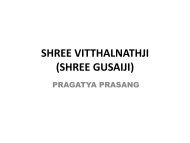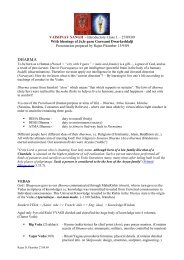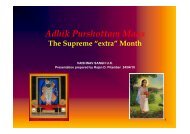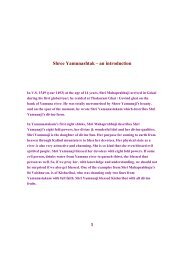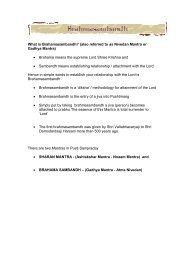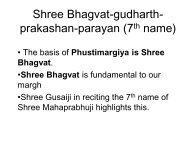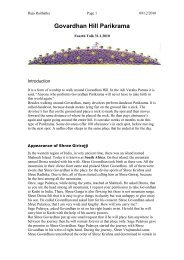Ekadashi - basic understanding - Vaishnav Sangh of UK
Ekadashi - basic understanding - Vaishnav Sangh of UK
Ekadashi - basic understanding - Vaishnav Sangh of UK
Create successful ePaper yourself
Turn your PDF publications into a flip-book with our unique Google optimized e-Paper software.
<strong>Ekadashi</strong> - <strong>basic</strong> <strong>understanding</strong><br />
Ekadasi is a sanskrit word and it literally means “the eleventh day.”<br />
It refers to the eleventh day <strong>of</strong> the fortnight belonging to a lunar month<br />
(there are two fortnights in a lunar month – the bright and dark fortnight) - the period<br />
between New Moon Day and Full Moon Day is called Shukla Paksha and the second<br />
fortnight <strong>of</strong> the month is called Krishna-Paksha, or the period <strong>of</strong> the fading moon.<br />
Calendars count integer days, so months may be 29 or 30 days in length, in some<br />
regular or irregular sequence. But all lunar months approximate the mean length <strong>of</strong><br />
the synodic month <strong>of</strong> approximately 29.53059 days (29 days, 12 hours, 44 minutes<br />
and 3 seconds).<br />
There are two Ekadasis in a month: on the eleventh daya after the new moon, and<br />
on the eleventh day after the full moon. Those interested in advancing in pushtimarg must<br />
observe Ekadasi regularly.<br />
Ekadasi fast in the simplest manner prescribed in scripture, by refraining from eating<br />
grains, beans, peas and dahl – however complete fasting is recommended.<br />
Not only food, but also sleep is supposed to be given up or minimized on Ekadasi<br />
and one may stay awake all night on Ekadasi, chanting the glories <strong>of</strong> the Lord.
Full fasting on Ekadasi is good for health and good practice in restraining the senses,<br />
yet the main purpose <strong>of</strong> observing Ekadasi is to increase remembrance <strong>of</strong> Lord Krishna.<br />
One who thinks <strong>of</strong> food instead <strong>of</strong> Lord Krishna gets little benefit from fasting.<br />
“Upvas” in Sanskrit means to be near or to be closer. One should have no food or simple<br />
food and spend more time remembering Lord Krishna.<br />
Fasting will also help one to control his own senses and mind through self discipline.<br />
As people do not see any philosophical significance, in the modern world it has been noted<br />
that the number <strong>of</strong> people observing <strong>Ekadashi</strong> has been decreasing and most <strong>of</strong> them<br />
follow mechanically or blindly.
Period <strong>of</strong> fast observance<br />
Observance <strong>of</strong> Ekadasi vrata is calculated to begin at sunrise.<br />
The period before sunrise is considered to be part <strong>of</strong> the previous day.<br />
So the Ekadasi vrata starts at sunrise and lasts until the next sunrise.<br />
We observe Ekadasi from sunrise to sunrise.<br />
Twelve midnight is the western astronomical calculation, but the Vedic astronomical<br />
calculation begins either from the sunrise or the moonrise generally it is sunrise.<br />
The calculation is that when the sun rises, Ekadasi tithi (date) must be there or else we<br />
accept that day as prior to Ekadasi.<br />
Some Vaisnavas are particular not to eat anything after sunset the night before, to make<br />
sure there is no undigested food left in the stomach on Ekadasi day.<br />
The <strong>basic</strong> principle is not just to fast, but to increase one's faith and love for Lord Krishna.<br />
The real reason for observing fasting on Ekadasi is to minimize the demands <strong>of</strong> the<br />
body and to engage our time in the service <strong>of</strong> the Lord by chanting or performing similar<br />
service.
Who is <strong>Ekadashi</strong><br />
There are few versions explaining the reasoning for <strong>Ekadashi</strong>, below mentioned are two <strong>of</strong> them:<br />
In the Satya-yuga there once lived an amazing fearsome demon called Mura.<br />
Always very angry, he terrified all the demigods, defeating even Indra, the king <strong>of</strong> heaven;<br />
Vivasvan, the sun-god; the eight Vasus; Lord Brahma; Vayu, and Agni.<br />
Then the demigods approached Lord Visnu, and prayed to Him for help. Hearing the prayers<br />
and request from Indra, Lord Visnu and other demigods, advanced to combat Mura at<br />
his capital city <strong>of</strong> Candravati.“<br />
Then there was a big fight between the soldiers <strong>of</strong> Mura and the demigods. Many<br />
hundreds <strong>of</strong> demons were killed by the Lord's hand. At last the chief demon, Mura, began<br />
fighting with the Lord, first with weapons, then with bare hands. The Lord wrested with<br />
Mura for one thousand celestial years and then, apparently fatigued, left for Badarika-asrama.<br />
There He entered a very beautiful cave, named Himavati, to rest.<br />
The demon followed Him into the cave, and, seeing Him asleep, started thinking within<br />
his heart: “Today I will kill this slayer <strong>of</strong> all demons, Hari”.
While the wicked demon Mura was making plans in this way, from Lord Visnu's body there<br />
manifested a young girl who had a very bright complexion. Mura saw that she was equipped with<br />
various brilliant weapons and was ready to fight. Challenged by that female to do battle, Mura<br />
prepared himself and then fought with her, but he became very astonished when he saw that she<br />
fought with him without cessation.<br />
The king <strong>of</strong> demons then said: "Who has created this angry, fearsome girl who is fighting me<br />
so powerfully, just like a thunderbolt falling upon me?" After saying this, the demon continued<br />
to fight with the girl.<br />
Suddenly that effulgent goddess shattered all <strong>of</strong> Mura's weapons and in a moment deprived him<br />
<strong>of</strong> his chariot. He ran toward her to attack her with his bare hands, but when she saw him coming<br />
she angrily cut <strong>of</strong>f his head. Thus the demon at once fell to the ground and went to the abode<br />
<strong>of</strong> Yamaraja.<br />
Then the Supreme Lord woke up and saw the dead demon before Him, as well as the maiden<br />
bowing down to Him with joined palms. The Lord, being pleased with the girl, <strong>of</strong>fered to give<br />
her a boon.<br />
The maiden said: "O Lord, if You are pleased with me and wish to give me a boon,<br />
then give me the power to deliver from the greatest sins that person who fasts on this day.
O Lord, whether a person observes complete fasting, eats only in the evening, or eats only<br />
at midday, please grant him a religious attitude, wealth, and at last liberation."<br />
The Supreme Personality <strong>of</strong> Godhead said:<br />
"O most pious lady, what you have requested is granted. All My devotees in this world will<br />
surely fast on your day, and thus they will become famous throughout the three worlds and<br />
finally come and stay with Me in My abode.<br />
Because you, My transcendental potency, have appeared on the eleventh day <strong>of</strong> the waning<br />
moon, let your name be Ekadasi. If a person fasts on Ekadasi, I will burn up all his sins<br />
and bestow upon him My transcendental abode.“<br />
The second version believes that as human being has five senses – eyes, ears, nose, tongue and<br />
skin. We also have five what we call motor organs – hands, feet, mouth, reproductive and<br />
excretory organs. The eleventh being the MIND.<br />
Mind makes the decision by directing the motor organs to perform certain deeds, utilising<br />
the sense organs to enjoy the fruits <strong>of</strong> the deeds.
<strong>Ekadashi</strong> – An astrological phenomenon<br />
The planetary / solar system is inter-related and we form part <strong>of</strong> this system (By a system we<br />
mean an organism or organisation which is methodically arranged).<br />
When we know that we belong to the system <strong>of</strong> planetary motions, we understand thereby<br />
that we are an inseparable part <strong>of</strong> the system. The gravitational pull <strong>of</strong> planets has an influence<br />
on us.<br />
We belong to the solar system—a huge family <strong>of</strong> which the sun is the head and the planets<br />
are the members. The sun guides the activities <strong>of</strong> this family and we, being contents <strong>of</strong> this<br />
system, cannot be out <strong>of</strong> the influence <strong>of</strong> the sun.<br />
We are involved in the laws operating in this system. This has led to the discovery <strong>of</strong><br />
astrology. Astronomy studies the movements <strong>of</strong> planets and stars, and astrology the effects<br />
they produce on the contents <strong>of</strong> the system.<br />
The entire personality <strong>of</strong> ours is tremendously influenced by the movement <strong>of</strong> planets.<br />
There is no use imagining that the planets are above our heads. They are everywhere. There is<br />
a relative movement <strong>of</strong> planets among which the earth is one.<br />
There is no planet which is static. Even the sun is not ultimately static. The whole solar system<br />
is moving and rushing towards some huge star, which is eighty million times larger and brighter<br />
than the sun, whose light has not yet reached us, as astronomers tell us.
The sun is said to influence the centre <strong>of</strong> our personality; hence the sun is called Atmakaraka.<br />
He is the soul-influencer <strong>of</strong> the human body. In the Rig-veda, the sun is identified with the soul<br />
<strong>of</strong> the universe as well as the soul <strong>of</strong> the individual.<br />
The different limbs <strong>of</strong> our body and different parts <strong>of</strong> our system are supposed to be influenced<br />
by different planets. The sun is capable <strong>of</strong> influencing the entire being. He is, thus, the<br />
Atmakaraka. Karaka is doer, manipulator, director. If there is no sun, we know what difference<br />
it makes for us; our digestion becomes sluggish on days when there is no sun. The moon is<br />
supposed to influence the mind.<br />
Planets are not spiritual bodies, and yet they influence the mind. The mind's presiding deity<br />
is moon. Ekadasi is particularly relevant to this relation <strong>of</strong> moon and mind.
How, is Ekadasi related to the movement <strong>of</strong> moon and mind?<br />
We have certain centres called Chakras in the body. The Chakras are nothing but energy-centres<br />
which whirl in some direction as water whirls in a river.<br />
Chakra is a wheel or circular motion. They move in a spiral shape. They are not physical;<br />
but psycho-physical and psychological. These Chakras are neither in the mind nor in the body;<br />
they are in the astral body. (Astral body is a spiritual counterpart <strong>of</strong> the physical body. It is an<br />
intermediate between intelligent soul and physical body).<br />
The moon's influence physically on the body has an influence on the Chakras, which tells<br />
upon the mind ultimately. The mind moves through these Chakras. The passage <strong>of</strong> the mind is<br />
through these Chakras, up and down. When this operation takes place consciously, it is called<br />
Yoga; when done unconsciously by the mind, it is just influence.<br />
When the moon waxes or wanes, the mind is vehemently influenced. So people who are not<br />
normal in their minds become very bad on the full-moon and new-moon days. You cannot<br />
see the moon's influence on the earth because it is solid, but it can be seen on the ocean<br />
which is liquid.<br />
This happens due to the tw<strong>of</strong>old pressure <strong>of</strong> the relation <strong>of</strong> the earth and moon. The sun<br />
influences the moon and the moon influences the earth. When the influence occurs<br />
automatically, we are instruments in the hands <strong>of</strong> Nature. When it is done consciously, we are<br />
said to practise Yoga.
We can be involuntarily dragged from place to place, or we can walk voluntarily. The difference<br />
is obvious. The moon's movement tells upon the movement <strong>of</strong> the mind through the Chakras.<br />
Another important aspect is the seat <strong>of</strong> the mind which is also tw<strong>of</strong>old. You may be living in<br />
many houses, <strong>of</strong> which one or two are your own. Svasthana means 'One's own place.' The<br />
mind has several abodes or centres <strong>of</strong> energy called Chakras, <strong>of</strong> which two are its own.<br />
The seats <strong>of</strong> the mind in this personality <strong>of</strong> ours are: 1. the subtle spot in the astral body<br />
corresponding to the centre <strong>of</strong> the two eye-brows, in waking, and 2. the heart, in the state <strong>of</strong> deep<br />
sleep. If it is in the brain, it is active and you, then, do not get sleep, because it refuses to go down<br />
If the mind is midway between the centre <strong>of</strong> the eye-brows and the heart, it is dream state. So,<br />
there is a tw<strong>of</strong>old centre <strong>of</strong> the mind,—the Ajna-Chakra, or the centre between the eye-brows,<br />
and the Anahata Chakra, or the heart. In both these centres, the mind feels at home and is at<br />
ease, because it is nearer to itself. In other centres it is extrovert.<br />
In the two fortnights, in its movement, it finds itself at the Ajna Chakra and the Anahata Chakra<br />
on the eleventh day. Since these two Chakras are its own abode, the mind is at home here, i.e.,<br />
it gets concentrated and collected easily.
You are capable <strong>of</strong> concentration when the mind is naturally in its home. The mind cannot be<br />
concentrated when it is out <strong>of</strong> tune, but when it is in its location it is easy <strong>of</strong> contemplation.<br />
so, the Ekadasi day in both fortnights is the occasion when the mind finds itself in its<br />
place - in the bright fortnight in the Ajna Chakra, and in dark fortnight in the Anahata Chakra.<br />
Yogis take advantage <strong>of</strong> these two days and try to practise deep meditation. <strong>Vaishnav</strong>as treat<br />
Ekadasi as a very holy day and also observe a fast on that day.<br />
The seven chakras – Details<br />
First chakra – Muladhara<br />
Second chakra – Svadhisthana<br />
Third chakra – Manipura<br />
Fourth chakra – Anahata<br />
Fifth chakra – Vishudda<br />
Sixth chakra – Ajna<br />
Seventh Chakra – Sahasrara chakra
Relation between fast and meditation<br />
There is really no intrinsic connection between fast and meditation, but there is some advantage<br />
in keeping the body light and the stomach free from excessive metabolic function.<br />
Hence, there is no advantage in giving the physical system work on days you want to do Yogic<br />
practice. Thus, Ekadasi has also a spiritual significance.<br />
Thus the observance <strong>of</strong> Ekadasi has many advantages—physical, astral, spiritual—and because<br />
this day has connection with the relation <strong>of</strong> the mind with its abode together with the moon,<br />
you feel mysteriously helped in your meditation and contemplation - mysteriously because you<br />
cannot know this consciously. But you can feel this for yourself by observing it.
Tithi<br />
Pratipat: The presiding deity <strong>of</strong> the first lunar day in Brahma and is good for all types <strong>of</strong><br />
auspicious and religious ceremonies<br />
Dvitiya: Vidhatr rules this lunar day and is good for the laying <strong>of</strong> foundations for buildings and<br />
other things <strong>of</strong> a permanent nature.<br />
Tritiya: Visnu is the lord <strong>of</strong> this day and is good for the cuttings <strong>of</strong> one's hair and nails and<br />
shaving.<br />
Chaturthi: Yama is lord <strong>of</strong> the 4th lunar day, which is good for the destruction <strong>of</strong> one's enemies,<br />
the removal <strong>of</strong> obstacles, and acts <strong>of</strong> combat.<br />
Panchami: The Moon rules this day, which is favourable for administering medicine, the purging<br />
<strong>of</strong> poisons, and surgery.<br />
Shashti: Karttikeya presides over this day and is favourable for coronations, meeting new friends,<br />
festivities, and enjoyment.<br />
Saptami: The 7th lunar day is ruled by Indra; one may begin a journey, buy conveyances, and<br />
deal with other such things as a movable nature.
Ashtami: The Vasus rule this day, which is good for taking up arms, building <strong>of</strong> one's defenses,<br />
and fortification.<br />
Navami: The Serpent rules this day, with is suitable for killing enemies, acts <strong>of</strong> destruction, and<br />
violence.<br />
Dasami: The day is ruled by Dharma and is auspicious for acts <strong>of</strong> virtue, religious functions,<br />
spiritual practices, and other pious activities.<br />
Ekadasi: Rudra rules this day; fasting, devotional activities, and remembrance <strong>of</strong> the Supreme<br />
Lord are very favourable.This day has special religious significance in Hinduism and Jainism<br />
usually observed by fasting<br />
Dvadasi: The Sun rules this day, which is auspicious for religious ceremonies the lighting <strong>of</strong> the<br />
sacred fire, and the performance <strong>of</strong> one's duties.<br />
Trayodasi: The day is ruled by Cupid and is good for forming friendships, sensual pleasures,<br />
and festivities.<br />
Chaturdashi: Kali rules this day suitable for administering poison and calling <strong>of</strong> elementals<br />
and spirits.<br />
Amavasya (new moon) or Purnima (full moon): The Vasve-devas rule the New Moon suitable<br />
for the propitiation <strong>of</strong> the Manes and performance <strong>of</strong> austerities.
<strong>Ekadashi</strong> Month Vedic Month English<br />
Saphala <strong>Ekadashi</strong> Pausha Krishna Paksh Dec - Jan<br />
Putrada <strong>Ekadashi</strong> Pausha Shukla Paksh Dec - Jan<br />
Sat Tila <strong>Ekadashi</strong> Magha Krishna Paksh Jan - Feb<br />
Bhaimi <strong>Ekadashi</strong> Magha Shukla Paksh Jan - Feb<br />
Vaikunta Ekadasi Phalgun Krishna Paksh Feb - Mar<br />
Amalaki <strong>Ekadashi</strong> Phalgun Shukla Paksh Feb - Mar<br />
Papamochani <strong>Ekadashi</strong> Chaitra Krishna Paksh Mar - Apr<br />
Kamada <strong>Ekadashi</strong> Chaitra Shukla Paksh Mar - Apr<br />
Varuthini <strong>Ekadashi</strong> Vaisakh Krishna Paksh Apr - May<br />
Mohini <strong>Ekadashi</strong> Vaisakh Shukla Paksh Apr - May<br />
Apara <strong>Ekadashi</strong> Jyeshtha Krishna Paksh May - Jun<br />
Pandava <strong>Ekadashi</strong> Jyeshtha Shukla Paksh May - Jun<br />
Yogini <strong>Ekadashi</strong> Ashaad Krishna Paksh Jun - Jul<br />
Shayani <strong>Ekadashi</strong> Ashaad Shukla Paksh Jun - Jul<br />
Kamika <strong>Ekadashi</strong> Shravan Krishna Paksh Jul - Aug<br />
Pavitropana <strong>Ekadashi</strong> Shravan Shukla Paksh Jul - Aug<br />
Annada <strong>Ekadashi</strong> Bhadrapad Krishna Paksh Aug - Sep<br />
Parsva <strong>Ekadashi</strong> Bhadrapad Shukla Paksh Aug - Sep<br />
Indira <strong>Ekadashi</strong> Ashwin Krishna Paksh Sep - Oct<br />
Pasankusha <strong>Ekadashi</strong> Ashwin Shukla Paksh Sep - Oct
<strong>Ekadashi</strong> Month Vedic Month English<br />
Rama <strong>Ekadashi</strong> Kartik Krishna Paksh Oct - Nov<br />
Prabodhini <strong>Ekadashi</strong> Kartik Shukla Paksh Oct - Nov<br />
Utpanna <strong>Ekadashi</strong> Margasirsha Krishna Paksh Nov - Dec<br />
Mokshada <strong>Ekadashi</strong> Margasirsha Shukla Paksh Nov – Dec<br />
Padmini <strong>Ekadashi</strong> Purushottam Shukla Paksh<br />
Parama <strong>Ekadashi</strong> Purushottam Krishna Paksh



